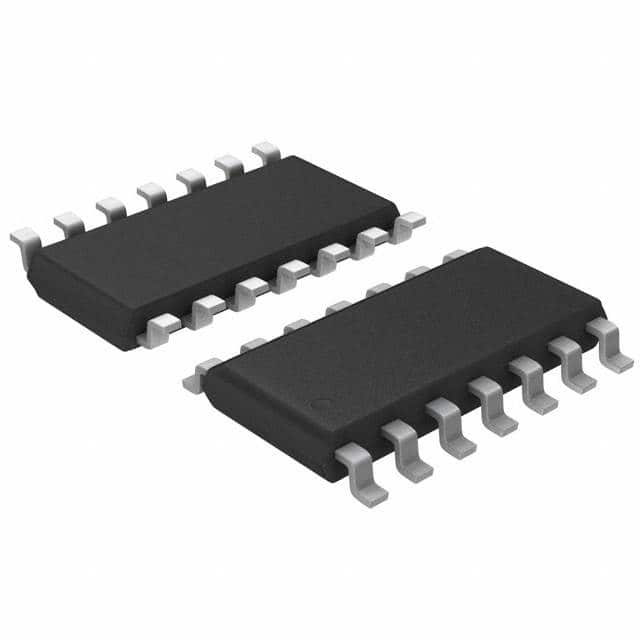Voir les spécifications pour les détails du produit.

74HC164S14-13
Product Overview
Category
The 74HC164S14-13 belongs to the category of integrated circuits (ICs).
Use
This IC is commonly used for serial-in, parallel-out shift register applications.
Characteristics
- Serial-in, parallel-out shift register functionality
- High-speed operation
- Wide operating voltage range
- Low power consumption
- Compatibility with other TTL logic families
- Schmitt-trigger action on all inputs
Package
The 74HC164S14-13 is available in a small-outline package (SOP) format.
Essence
The essence of this product lies in its ability to convert serial data into parallel output, making it suitable for various digital applications.
Packaging/Quantity
The 74HC164S14-13 is typically packaged in reels or tubes, with a quantity of 2500 units per reel/tube.
Specifications
- Supply Voltage: 2V to 6V
- Input Voltage: -0.5V to VCC + 0.5V
- Output Voltage: -0.5V to VCC + 0.5V
- Operating Temperature Range: -40°C to +125°C
- Maximum Clock Frequency: 25 MHz
Detailed Pin Configuration
The 74HC164S14-13 has a total of 14 pins, each serving a specific function:
- GND: Ground
- SER: Serial Data Input
- QA: Parallel Output A
- QB: Parallel Output B
- QC: Parallel Output C
- QD: Parallel Output D
- QE: Parallel Output E
- QF: Parallel Output F
- QG: Parallel Output G
- QH: Parallel Output H
- MR: Master Reset
- CP: Clock Pulse Input
- VCC: Supply Voltage
- OE: Output Enable
Functional Features
The 74HC164S14-13 offers the following functional features:
- Serial-in, parallel-out shift register operation.
- High-speed data transfer with a maximum clock frequency of 25 MHz.
- Compatibility with various TTL logic families, allowing for easy integration into existing systems.
- Schmitt-trigger action on all inputs ensures reliable and noise-immune operation.
- Low power consumption makes it suitable for battery-powered applications.
Advantages and Disadvantages
Advantages
- High-speed operation enables efficient data processing.
- Wide operating voltage range allows for flexibility in different applications.
- Low power consumption helps conserve energy.
- Compatibility with other TTL logic families simplifies system integration.
- Schmitt-trigger action ensures reliable operation even in noisy environments.
Disadvantages
- Limited number of parallel outputs (8 in total).
- May require additional components for certain applications, such as pull-up resistors.
Working Principles
The 74HC164S14-13 operates based on the principle of serial-in, parallel-out shifting. It receives serial data through the SER pin and shifts it internally based on the clock pulse received at the CP pin. The shifted data is then available in parallel form at the output pins QA to QH. The MR pin can be used to reset the shift register to its initial state, while the OE pin allows for enabling or disabling the output.
Detailed Application Field Plans
The 74HC164S14-13 finds applications in various fields, including but not limited to:
- Data communication systems
- Industrial automation
- Consumer electronics
- Automotive electronics
- Robotics
- Instrumentation and measurement devices
Detailed and Complete Alternative Models
Some alternative models that offer similar functionality to the 74HC164S14-13 include:
- 74LS164
- CD4014
- SN74HC595
- CD74HC165
These alternative models can be considered based on specific requirements and compatibility with existing systems.
Word count: 529 words
Énumérez 10 questions et réponses courantes liées à l'application de 74HC164S14-13 dans les solutions techniques
Sure! Here are 10 common questions and answers related to the application of 74HC164S14-13 in technical solutions:
Q: What is the 74HC164S14-13? A: The 74HC164S14-13 is a 14-stage serial-in parallel-out shift register IC, commonly used for data storage and transfer in digital circuits.
Q: What is the operating voltage range of the 74HC164S14-13? A: The 74HC164S14-13 operates within a voltage range of 2V to 6V.
Q: How many bits can the 74HC164S14-13 store or transfer? A: The 74HC164S14-13 can store or transfer up to 14 bits of data.
Q: What is the maximum clock frequency supported by the 74HC164S14-13? A: The 74HC164S14-13 can support clock frequencies up to 25 MHz.
Q: Can the 74HC164S14-13 be cascaded to increase the number of stages? A: Yes, multiple 74HC164S14-13 ICs can be cascaded together to increase the number of stages and expand the data storage capacity.
Q: How does the 74HC164S14-13 handle input data? A: The 74HC164S14-13 uses a serial input pin (SER) to receive data bit by bit, which is then shifted through the internal stages on each clock pulse.
Q: How can I read the stored data from the 74HC164S14-13? A: The parallel output pins (Q0-Q13) of the 74HC164S14-13 can be connected to other digital components or microcontrollers to read the stored data.
Q: Can the 74HC164S14-13 be used for driving LEDs or other outputs? A: Yes, the parallel output pins of the 74HC164S14-13 can be directly connected to LEDs or other outputs to control their states.
Q: Does the 74HC164S14-13 have any built-in protection features? A: The 74HC164S14-13 has built-in ESD protection on all inputs and outputs, providing some level of protection against electrostatic discharge.
Q: Are there any specific application examples for the 74HC164S14-13? A: The 74HC164S14-13 is commonly used in applications such as LED matrix displays, shift register-based data storage systems, and serial-to-parallel data conversion circuits.
Please note that these answers are general and may vary depending on the specific implementation and requirements of your technical solution.

